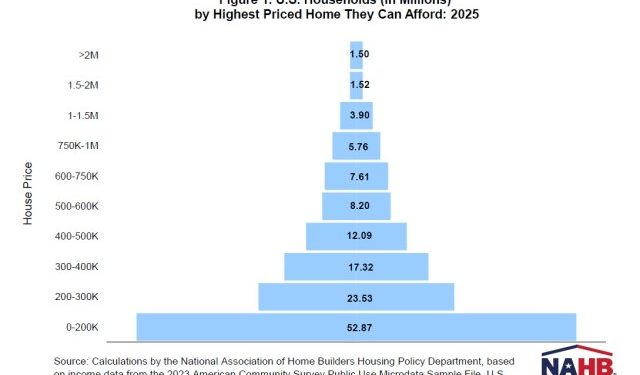Nahb recently published its 2025 price analysis, highlighting the challenge of the affordability of housing. Although the previous items have discussed the impacts of the rise in house prices and interest rates on affordability, this position focuses on the affordable pyramid of American housing. The pyramid reveals that 70% of households (94 million) cannot afford a house of $ 400,000, while the estimated median price of a new house is around $ 460,000 in 2025.
The affordable housing pyramid illustrates the number of households capable of buying a house at different price stages. Each step represents the number of households that can only afford houses in this specific price range. Most of the households are the first step, where the houses are less than $ 200,000. As the prices of houses are increasing, fewer and fewer households can afford the next price level, with the most expensive houses – those of more than $ 2 million – with the smallest number of potential buyers. The affordability of the accommodation remains an essential challenge for households with income at the lower end of the spectrum.

The pyramid is based on income thresholds and subscription standards. Under these assumptions, the minimum income required to buy a house of $ 200,000 at the mortgage rate of 6.5% is $ 61,487. In 2025, around 52.87 million households in the United States would have no income that this threshold and, therefore, can only afford to buy houses at a price of $ 200,000. These 52.87 million households form the lower step of the pyramid. Among the remaining households that can afford a house for $ 200,000, 23.53 million can only afford to pay a highest price between $ 200,000 and $ 300,000. These households constitute the second stage of the pyramid. Each next step is narrowed further, reflecting the number of households that can afford increasingly expensive houses.
It is advisable to compare the number of households which can afford houses at different levels and the number of houses occupied by the owner available in these ranges (excludes houses built for milk), as shown in Figure 2. For example, while 53 million households can afford a house at a price of $ 200,000 or less, there are only 22 million houses occupied at home in this price range. This trend continues in the price range from $ 200,000 to $ 300,000, where the number of households that can afford houses is much higher than the number of housing units in this range. These imbalances show a shortage of affordable housing.

Learn more about the eye on the accommodation
Subscribe to get the latest articles sent to your email.


